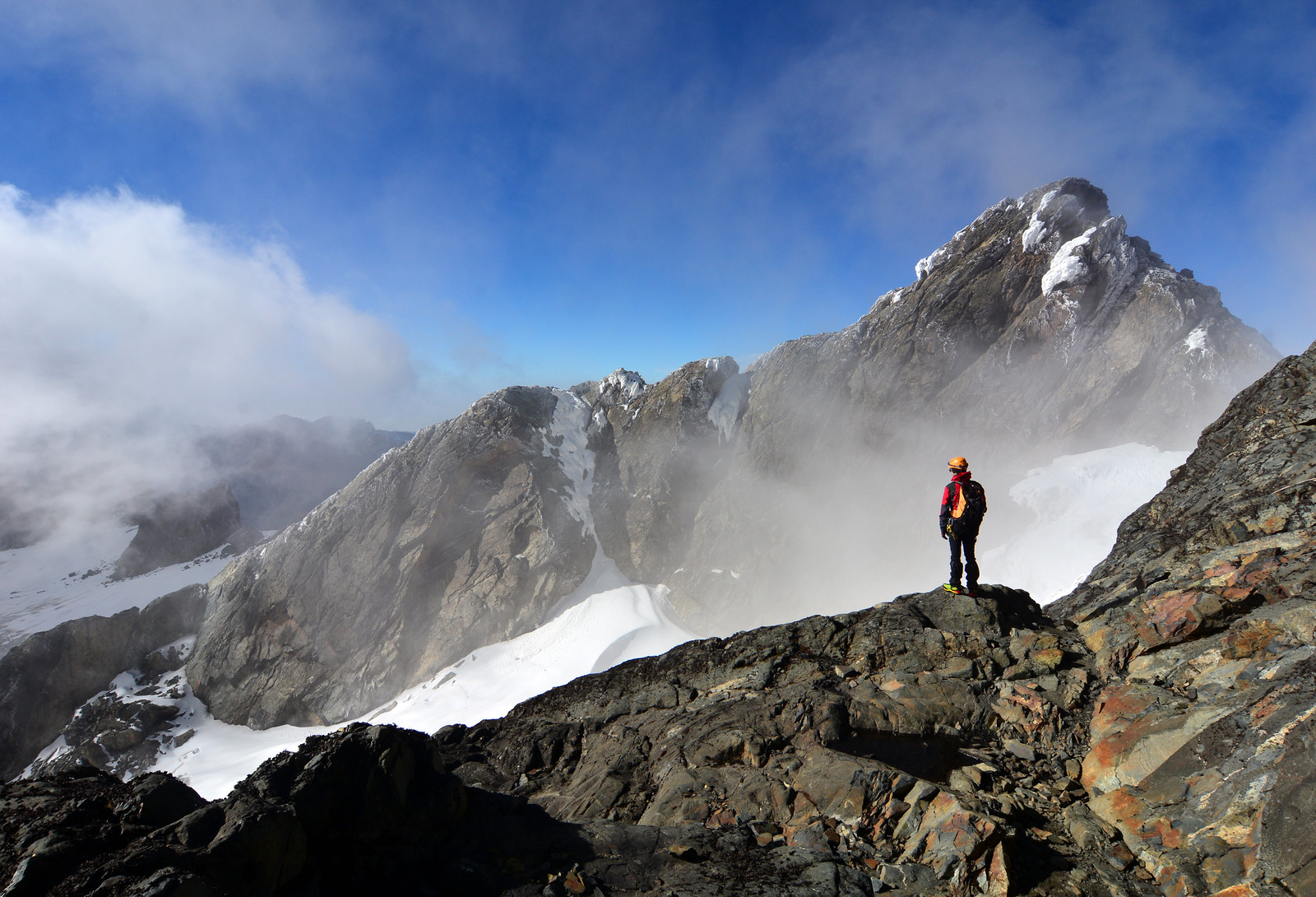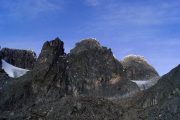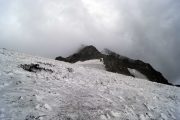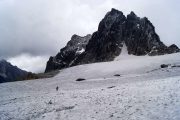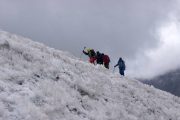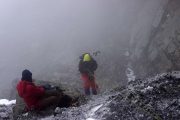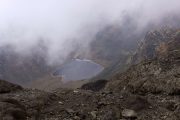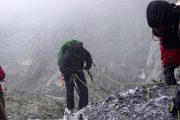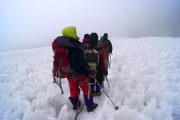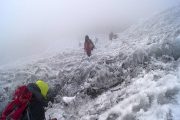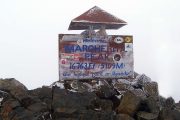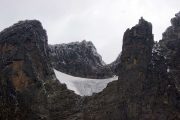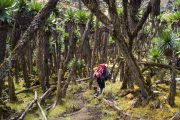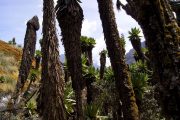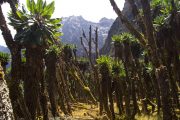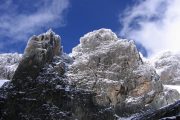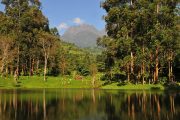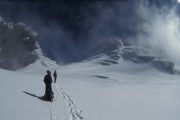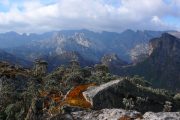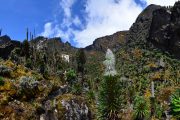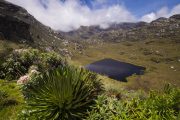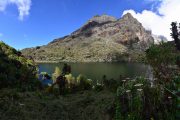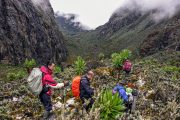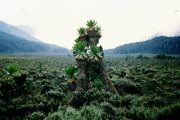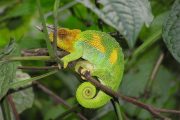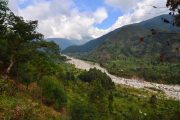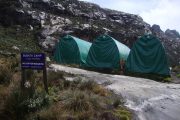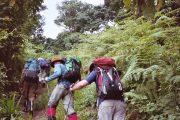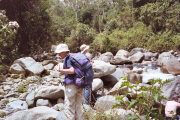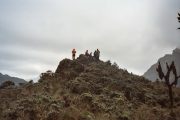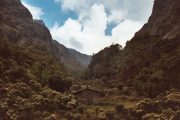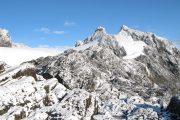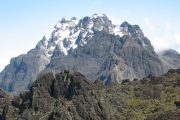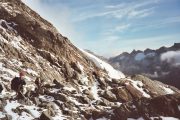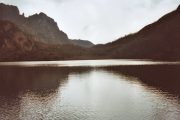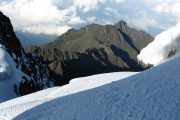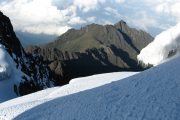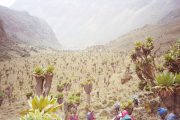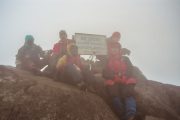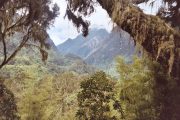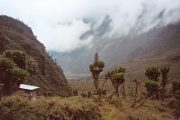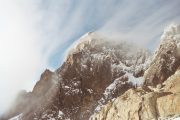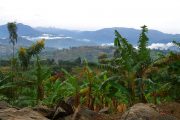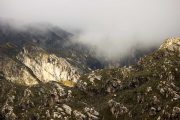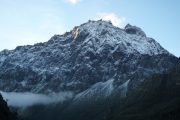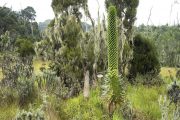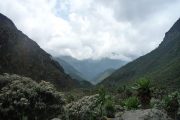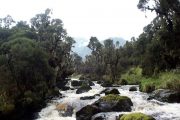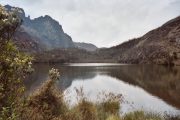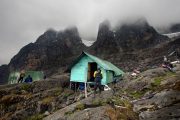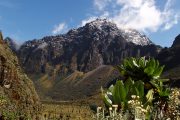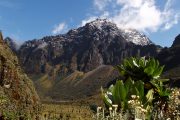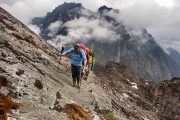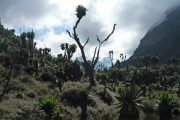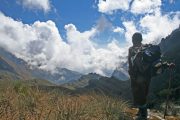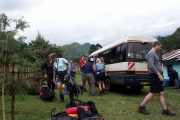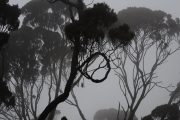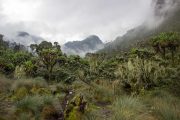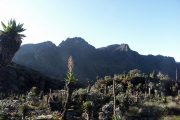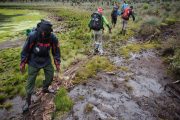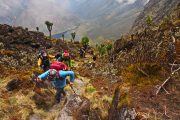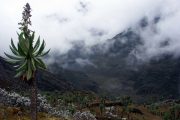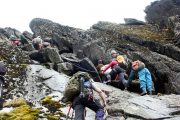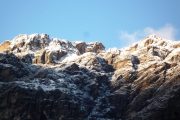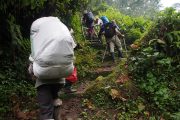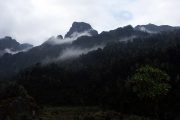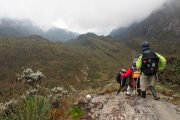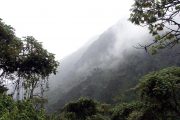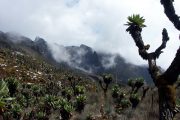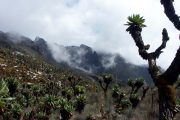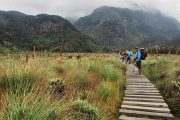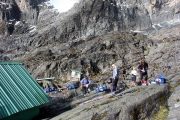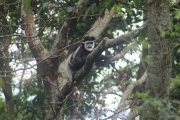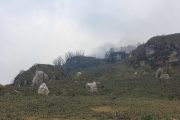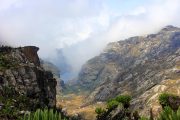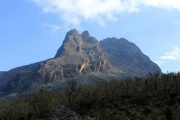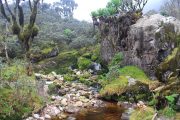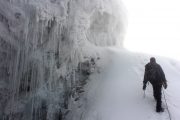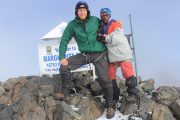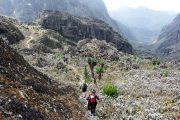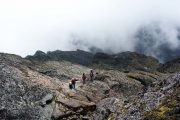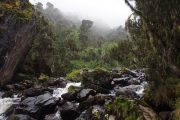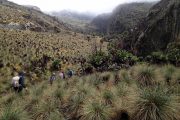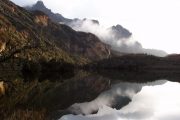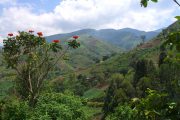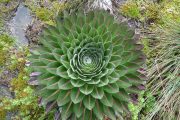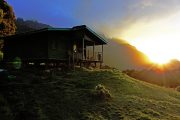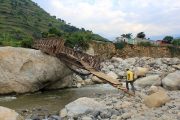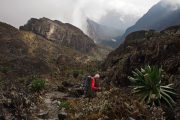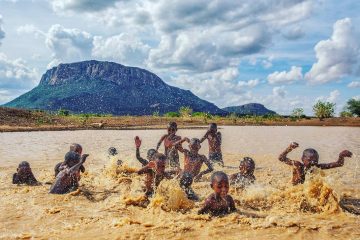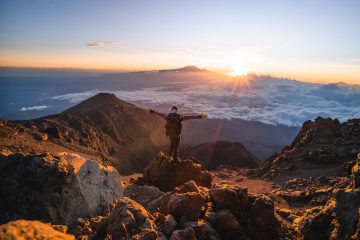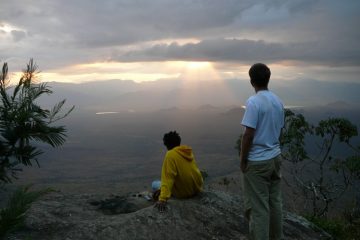Trek the Rwenzori Mountains using the Kilembe Trail for 7 days. There are two routes that lead to the Margherita Peak on the Rwenzori Mountains. These routes are the Kilembe Trail and the Central Circuit Trail. Margherita Peak is the favourite place for mountaineers that choose Uganda.
You can either choose the 8 days Kilembe Trail or the 8 Days Central Circuit Trail hike to get to Margherita Peak as they will both reward you with amazing adventure and scenery on the Rwenzori Mountains as you summit the Margherita Peak, the highest point on Rwenzori.
The Kilembe hike trail, popularly known as the “Southern Circuit” of the Rwenzori Mountains has the trail marked with huts and it is managed by Uganda’s Rwenzori Trekking Services (RTS).
Rwenzori Kilembe Trail at a Glance
The trail of Kilembe begins with a trek to the following huts: – Sine Hut (2,585 m), Kalalama Camp (3.147m) to Mutinda Camp (3.688 m), Bugata Camp (4.062 m), Butawu Camp (3.974 m), Margherita Camp (4,485 m.) and you will return to Butawu Camp on the same day you reach the summit, descend to Kiharo Camp (3,460 m.) and finally the rangers post which will mark the end of the 7 days Kilembe hiking trail on Rwenzori Mountains.
For the 7 Days Rwenzori Kilembe Trail Hike the tour begins from Kasese town at the Rangers’ post and ends with a trip to Kampala. Climbers have the option of skipping one overnight camp or we have an option of jumping an overnight camp stay on summit day. Instead of spending a night near the peak, you can opt to descend after reaching the Magherita Peak.
About the Rwenzori Mountains
Rwenzori Mountains National Park was officially declared a national park in the year 1991 and is both recognized as a World Heritage site and a Ramsar site. The park covers an area of about 996km2. . The highest point on Rwenzori Mountain is the Margherita Peak that stands 5,109m above sea level and it stands on Mt Stanley, a mountain that stands on the border that separates Uganda and the Democratic Republic of Congo. one amazing fact about the Rwenzori is that in AD 150, geographer Ptolemy from Alexandria in Greece, gave these mountains the name “Mountains of the Moon”.
Getting there
Rwenzori is located in the South-Western part of Uganda and Entebbe International Airport is the nearest airport to Rwenzori National Park. From the airport, you can take a shuttle or minibus to Rwenzori or to Kampala, another minibus to Kasese then Kalembe if you are using public transport.
Best time to trek the Rwenzori Mountains
The best time to hike the Rwenzoris is during the dry months between December and March or from July to September.
Need to know
You will need a tourist visa for entering Uganda, a process that can be done easily done online and usually take a few hours to be sent to you via email. For a 90 days visa, it would cost you about $50 (USD currency only)applications can be done online here – visas.immigration.go.ug.
Why choose the Rwenzori over Mount Kilimanjaro?
Since the Rwenzori mountains are not as popular as Mount Kilimanjaro, they do not attract as many climbers as Mount Kilimanjaro, meaning that, the routes are less crowded and the high altitude vegetation is more lively. Even though Tanzania’s Mount Kilimanjaro is the highest in Africa, Uganda’s Rwenzori mountain range is one of Africa’s top hiking destination, holding three of Africa’s five highest peaks.
Kilembe (1,450m) to Kalalama Camp (3147m)
This is the first day of 7 Days Kilembe Trail expedition and it begins with a hike from the rangers post at Kilembe to the Rwenzori national park entrance point for registration, meeting with your mountain crew and gaining access into this park to start your hike.
Take a walk at the base of the mountain’s rainforest zone that is home to various animals including an array of various monkey species like the colobus monkeys, the blue monkeys, and the endemic birds like the Rwenzori Turaco. The day’s trek will take you to Sine camp for a much-needed lunch break and refreshments before you carry on with your trek to your first overnight camp at Kalalama which is located at an altitude of 3,147 m. This camp will be you camp for the night where you will have dinner, rest and overnight sleep as you prepare for day 2 of trekking.
Dinner and Overnight at Kalalama Camp.
Kalalama Camp (3.147m) to Mutinda Camp (3.688 m)
Arise and shine early in the morning at around 7 am for preparation of climbing Rwenzori on day 2 then have breakfast at around 9 am in the morning. Depart you camp for the day’s trek that traverses the bamboo-mimulopsis zone of Rwenzori, a steep climb with plenty of high steps that will lead you to your resting spot for refreshments and a hot cup of tea or coffee.
You will continue with your trek along the heather zone, crossing several streams and even waterfalls. The entire terrain is covered by blankets of green moss vegetation and many outcrops of Giant Heather trees, sometimes in a misty atmosphere.
The day’s trek leads you to Mutinda Camp, at an altitude of 3.688 m named after the Mutinda Peaks and you can ascend further for about 1 hour and 30 minutes to Mutinda Lookout at 3.925 m, before descending for another hour back to camp.
The moss-covered rock outcrops of Mutinda Lookout will reward you with amazing views across the Rwenzori Mountains, down to Kasese town and Lake George. You will return to the cabins of Mutinda Camp late in the evening for the much-needed rest, next day’s briefing,
Dinner and overnight at Mutinda Camp.
Mutinda Camp to Bugata Camp (4.062 m)
The third day of your journey to the Peak of Rwenzori begins with an early morning breakfast at 9 am then a trek across the boggy terrain that is characterized by typical marshy, wet vegetation and tussocks.
As you edge closer to the Alpine vegetation zone you will start seeing the giant lobelias (Lobellia gibberoa), the groundsel (Senecio adnivalis) and the everlasting flowers while you trek across the Mutinda valley. You will come across a steep ascent segment of your day’s trek up to Namusangi Valley (3.840 m) that will reward you with the best view of the Mutinda Peaks. Along the Namusangi Valley you will traverse various bogs as you head up to Bugata Camp that sits at an altitude of 4.062 m which is the arrival point of the day.
Weisman’s Peak on Mount Luigi of Savoy with is covered by the snow most of the time, is visible from the Bugata Camp filled with tussock grass, everlasting flowers, giant groundsel and giant lobelia.
This trek takes you through lake Kitandara that flows up to the Democratic republic of Congo. From the nearby Plozza Rock you will give you awesome views of nine lakes down the valley and Lake Nusuranja.
Bugata Camp is equipped with solar lights, eco-toilets and good bathrooms. It is here at Bugata Camp that you will rest, have dinner and sleep.
Dinner and overnight at Bugata Camp.
Bugata Camp to Hunwick’s Camp (3.974 m)
After early morning breakfast your trek will start with a steady ascent towards Bamwanjara Pass that features several long flat bogs and glacial lakes in the valley that extends beneath.
Finally getting to the top of Banwamjara Pass (4.450m) you will be rewarded with stunning views of all the main snowcapped peaks and it has small shelter for you to rest and enjoy the scenery.
You will then descend to both lower and upper Kachope lake which is rather steep and at plenty of times, very muddy but scenic as it offers amazing views of Kachope Lakes and McConnell’s Prong. Hunwick’s Camp (3,974m) is the arrival point of the day. The Camp sits on a ridge overlooking Rwenzori’s snowcapped Mt Baker.
Dinner and overnight at Hunwick’s Camp
From Hunwick’s Camp to Margherita Camp (4,485 m.)
We are getting closer to our goal of reaching the summit at Margherita with a day 5 trek on Rwenzori mountains. This trek leads us to Margherita Camp and we begin the trek by crossing several wet areas and small rivers originating from Mt Baker and Fresh fields Pass.
The climb to Scott Elliott Pass is an adventurous ascent traversing the pass and up the ridge of Mt Stanley to Margherita Camp at an altitude of 4,485 meters which is underneath Elena Hut of the Rwenzori Mountaineering Services.
It lies under a ring of high rocks and fascinatingly, it is the original camp that the Italian Prince Luigi Amadeo di Savoia, Duke of the Abruzzi used when he climber the Rwenzori Mountains.
Scott Elliot rewards you with stunning views of Mt Baker, Scott Elliot Pass and some of the high glaciers on Rwenzori’s Mt Stanley.
The hiking distance measures 4.2 kilometres. You will get here late in the evening and have some rest as you prepare for the summiting day the following day by preparing the ropes, hiking boots, ice-breaking axes as well as crampons a brief crash course that familiarize yourself with how to use this equipment and attires.
Dinner and overnight at Magherita Camp.
Hike to the Summit and back to Hunwick Camp
This day is reserved for making a summit attempt. It is essential to wake up a few hours after midnight, preferably at # am in the morning for a much dreaded and demanding hike to the top of the mountain.
After your early morning breakfast, you will embark on your summiting journey at around 4 am to Margherita peak on Rwenzori’s Mt Stanley. The main reason for this early trek is to make it through the glacier before sunrise as once it melts it will be difficult to pass through the glacier.
______________________________________________
The climb up Margherita glacier is steep and requires that you are fit. On getting near to the top of the glacier you then climb around an exposed section of rock, which is also bolted and roped, to get on the ridge running up to the top of Margherita Peak (5.109 m).
After reaching the summit you enjoy the scenic of almost the whole coun5ry as you are now at the highest point in the country. You will eat the special food package that you carried from day one at the starting point.
Descend back to the Ranger post
Wake up to the shrill calls of the Ruwenzori Turaco (Ruwenzorornis johnstoni) and other birds. After breakfast, you walk down the valley which is home to many species of birds that dive in and out of the thick vegetation.
Chameleons are a common sight as they crawl along the branches of the thick vegetation feeding on insects. In the clear areas, you may catch a glimpse of a Duiker quietly feeding surrounded by Giant Lobelias and a variety of flowering plants.
After descending a few kilometres, you climb two hundred metres height to a ridge overlooking the valley, before crossing several small valleys and streams to Kyalavula. Walk back to the Base Camp from where you will be awarded your Rwenzori hiking certificate and this will mark the end of this mesmerising hike.
English speaking trekking guide and Porters
During the trek, you will be accompanied at all times by a Rwenzori Mountains guide. Porters will join the group as well to help to carry the luggage. There will be 1 porter per hiker to carry his/her personal luggage. The other porters carry food, charcoal, cooking utensils, and a gas cylinder among others.
Accommodation
Accommodation during the trek is included in the price. You will spend your nights on the mountain in huts along the main circuit of the Rwenzori, such as the Nyabitaba hut, the John Matte Hut or the Bujuku Hut.
Meals
All meals are included during the trek. Breakfast, lunch, and dinner are served every day while on the trek. There is always powdered milk, chocolate drink, bread, sausages, packed juice, apples, chocolates, beef, rice, Irish potatoes, peas, and sandwiches. Lunch is not included on the first day of the trek.
Permits and Entrance Fees
In order to trek in the Rwenzori Mountains national park, you need a hiking permit and you need to pay the park’s entrance fees. These are included in the price of the trek.
Hiking Equipment
Hiking equipment such as crampons, ice ax, harness, helmet, gumboots are included in the trek.
Not included:
Airfare
You will have to make your way to Kampala, the starting point of this trek. Flight tickets to Uganda are not included in the price of the trek. In order to know which airlines fly to Entebbe International Airport (EBB), you can have a look at their website.
Transfer to Nyakalengija
This trek starts from Nyakalengija. You will have to make your way to this town. If you need help with the transfers, let us know and we can arrange it for you.
Accommodation before and after the trek
Before and after the trek you have to take care of your own accommodation in Kampala.
Travel Insurance
Your international travel insurance is your own responsibility. It is important that your travel insurance also covers adventures at a high altitude. Discuss your itinerary with the insurance company before your trek.
Sleeping bag and other equipment
Sleeping bags are not included in the trek, you will have to bring your own. Other necessary trekking equipment such as trekking boots, and warm gear are not included.
Personal expenses
Any personal expenses that may take place during the trek, such as buying snacks, souvenirs or alcoholic drinks are on your own account.
Water
As you hike the Rwenzori, you will not be provided with bottled water. You will get the water from the rivers and streams in the mountains because it’s clean. The locals drink it and they are okay. But if you don’t trust it, it’s okay to add some water filters to your water to avoid any inconveniences (these won’t be provided by your trekking company).
Tipping
Tips for the guide and porter are not included in the price of the trek. You decide how much to tip, but if you got a good service from your guide, be generous.
The formation of the Rwenzori mountains dates way back to about 3 million years ago. Unlike other volcanic mountains, the Rwenzori ranges are formed by uplifted blocks of crystalline gneiss, quartzite, amphibolite, and granite rocks.

